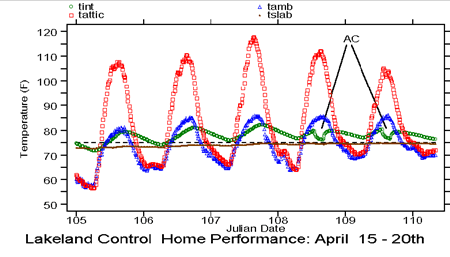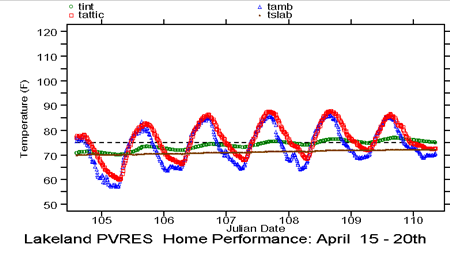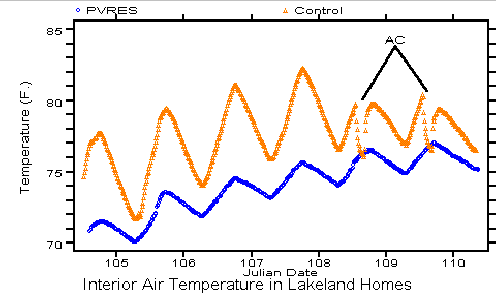
![]()
Thermal Performance Monitoring
The construction of the Control home was complete before the PVRES home. However, as soon as we were able to go inside the completed PVRES building after being inside the Control home, we noticed that the improved structure seemed much cooler inside.
So, as soon as the data aquistion system was in place we began comparative monitoring of the thermal performance of the two homes (Control and PVRES). We turned off all appliances in both homes and closed them up and recorded data for a five day period (April 16th - 20th) in an unoccupied and (mostly) unconditioned state. The data loggers recorded the the weather conditions and temperatures around the homes.
- Ambient air temperature outside
- Interior air temperature by the thermostat
- Temperature of the floor slab at a 2" depth
- Attic air temperature


Note the large differences in the attic air temperatures in the two homes-- even in mid April. The attic air reaches nearly 120°F in the Control home under its dark brown shingles while the attic under the white tile roof ranges only slightly around ambient air temperature. The interior air temperature in the PVRES home shows much less daily variation than the Control home. The comparison shows that the PVRES home averaged 4.3 degrees cooler (73.1° vs. 77.4°) than the Control home and was always cooler except on Saturday and Sunday when the Control home was air conditioned for several hours by a real estate agent in order to have the interior cool enough to show to prospective buyers (although the PVRES home is sold, the Control home is not). Interestingly, the air conditioning of the Control home was only able to slowly bring its temperature down to the temperature that the PVRES interior was floating at without air conditioning! During "float" conditions, the temperature also was less variable in the improved home-- ranging only from 70.1o to 75.6°F (5.5° difference) vs. 71.7° to 82.3°F (10.5° difference) in the Control.
Analysis showed that the long term temperatures in both homes slowly rose, because of the slow increase in daily air temperatures, but particularly because of the rise in the ground temperature as reflected in the steady increase in slab temperatures in the first two plots.
In summary, our base monitoring of the thermal performance of the envelopes of the two buildings showed large differences between the two-- a reflection of the influence of the cooler attic, the exterior insulation on the PVRES home and its high performance windows. So successful did these features appear in concert, that the PVRES building showed little need for air conditioning while the Control required mechanical cooling to keep its interior temperatures below 80°F.

